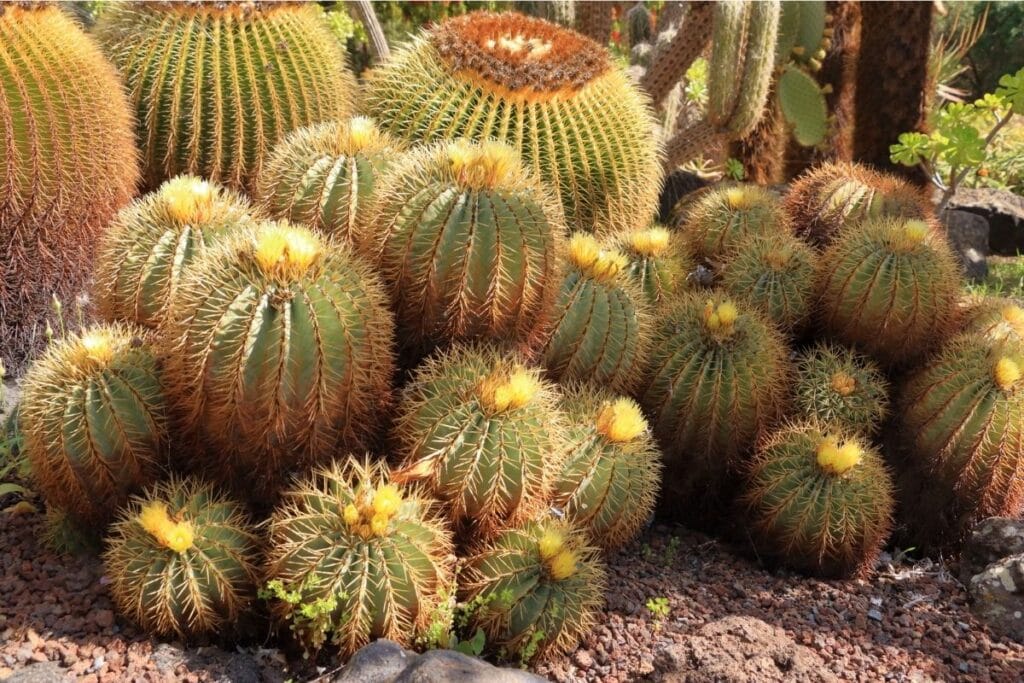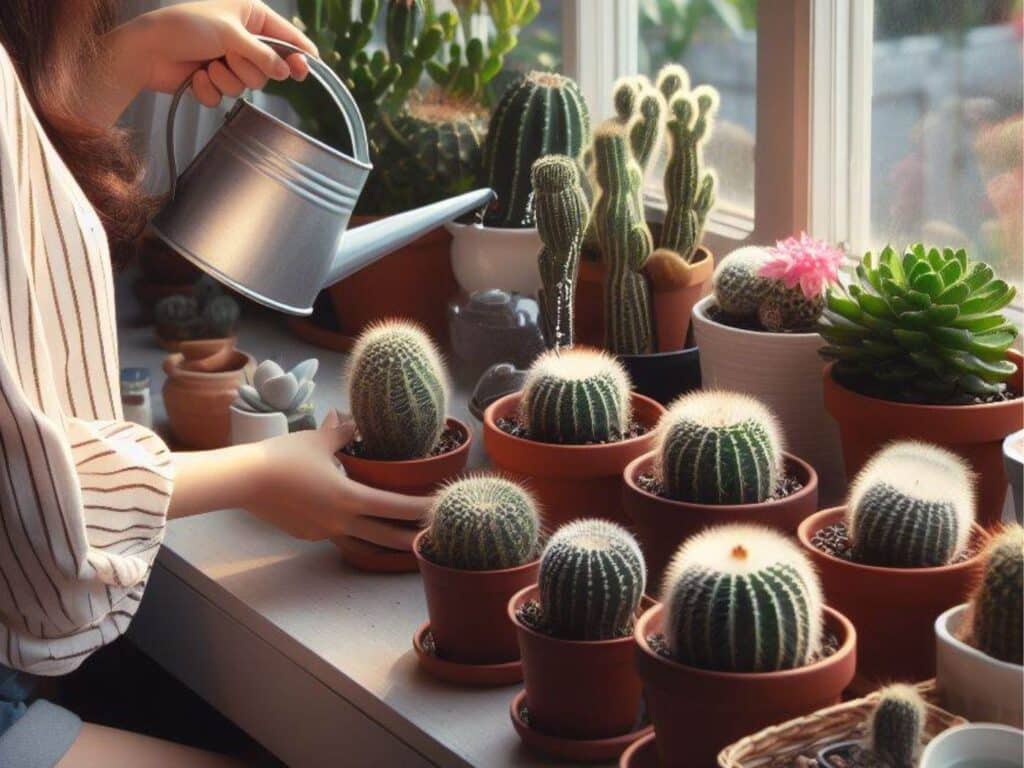Caring for a cactus may well seem straightforward, but there’s a delicate balance between neglect and overindulgence. If you’ve noticed your cactus looking a little worse for wear, it could be crying out for help due to overwatering—a common misstep for even the most attentive plant lovers.
Overwatering can lead to a host of issues, from root rot to fungal infections, turning your once-thriving desert dweller into a droopy, discolored mess.
Understanding the signs of an overwatered cactus and the steps to rescue it are crucial in reversing the damage. This article will guide you through identifying the problem, understanding its causes, and implementing solutions to revive your waterlogged friend.
With the right approach, you can restore your cactus to its former glory, ensuring it continues to add a touch of green to your space for years to come.
Understanding Cactus Water Needs
The Natural Habitat of Cacti
Cacti thrive in arid environments, where water is a precious commodity. In these regions, they’ve adapted to survive long periods without rainfall, storing water in their tissues to last through droughts.
This fundamental aspect of their nature is crucial for you to grasp. When you’re caring for a cactus at home, mirroring these desert-like conditions, rather than treating them like your average houseplant, helps keep them healthy.
Signs of Underwatering vs. Overwatering
Spotting the difference between a thirsty cactus and one that’s had too much to drink is key to avoiding common pitfalls. An underwatered cactus may well show signs of shriveling, as it uses up its water reserves.
Its skin may well become tight and puckered, signaling a need for moisture. On the flip side, an overwatered cactus often looks swollen and discolored, with its skin turning soft and potentially splitting due to excess water.
Yellowing or blackening at the base indicates root rot, a serious issue stemming from too much water. Learning to read these signals will help you strike the perfect balance, ensuring your spiky friend stays vibrant and vigorous.
The Effects of Overwatering on Cactus

How Overwatering Impacts Root Health
Overwatering leads to a hazardous environment for cactus roots. These plants, accustomed to dry conditions, suffer when their roots remain in wet soil for too long. This causes the roots to suffocate and rot since they cannot access the oxygen they require.
Think of it as trying to breathe with a wet blanket over your face – not a pleasant experience, right? The soggy conditions also attract unwanted fungal infections, which further degrade the root system, compromising the plant’s overall health and stability.
Identifying Rot in Overwatered Cacti
Spotting rot in an overwatered cactus requires a keen eye. Early signs include a soft, mushy base, discoloration starting from the bottom and spreading upwards, and an overall wilted appearance despite adequate watering.
If you suspect rot, gently remove the plant from its pot to inspect the roots. Healthy roots appear firm and white, while rotted roots are dark, slimy, and easily break apart. Catching these symptoms early can save your cactus from an untimely demise, turning a potentially sad story into a triumphant rescue mission.
Diagnosing an Overwatered Cactus

When your cactus starts looking a bit under the weather, overwatering could be the culprit. Let’s dive into the signs and prevention tactics to keep your spiky friend thriving.
Common Symptoms of Overwatering
First off, soggy soil is a giveaway that your watering habits may need a revision. If the soil resembles a swamp more than a desert, it’s a red flag. Next, a soft base or stem indicates that the cactus is absorbing more water than it can handle, leading to potential rot.
Discoloration, often appearing as yellow or brown on the plant, signifies damage within. Lastly, if your cactus is wilting or drooping, it’s screaming for help, as these plants are usually sturdy and upright. Spotting these signs early plays a crucial role in saving your overwatered cactus from meeting a mushy end.
The Role of Potting Mix and Drainage
Choosing the right potting mix and ensuring proper drainage can make all the difference. Cacti crave a mix that mimics their natural, arid habitats—a well-draining, sandy soil that allows water to pass through quickly, preventing moisture from lingering too long around the roots.
As for the pot, pick one with enough drainage holes. These aren’t just for decoration; they’re essential for letting excess water escape.
A good rule of thumb is to check the pot’s bottom if you suspect overwatering. No puddles should be forming there. Remember, a happy cactus is one that doesn’t sit in waterlogged conditions.
Immediate Actions to Save an Overwatered Cactus
Assessing the Extent of Damage
First, you’ll need to determine how much trouble your green friend is in. Gently remove the cactus from its pot to inspect the roots. Healthy roots appear white and firm, while rotting ones are brown or black and mushy.
A foul odor emanating from the roots signals decay. If the damage is localized, you’ve got a fighting chance to save your cactus. However, if the rot has spread extensively, the prognosis may well be grim.
- Trim Away the Rot: Using clean, sharp scissors or pruning shears, cut off the rotted roots and any affected parts of the cactus. This step may well feel a bit like surgery, but it’s for the sake of your plant’s health.
- Let it Dry: After trimming, leave your cactus out to dry for a few days. This pause gives the wounds time to callous over, which is crucial for preventing further infections. Think of it as a cactus spa day—minimalist and dry.
- Repot cactus with Fresh Soil: Once your cactus has had its rest, replant it in fresh, well-draining soil. A mix specifically for cacti is your best bet, as it prevents moisture from lingering too long around the roots.
- Change Your Watering Routine: Overwatering got you here, so it’s time to reassess how much H2O your cactus really needs. Cacti thrive on neglect, so water less frequently and only when the soil is completely dry. Think of watering as a rare treat, not a daily chore.
By closely monitoring and adjusting your care routine, your overwatered cactus can bounce back to its prickly glory. Remember, less water is more when it comes to these desert dwellers.
Preventive Measures for Cactus Care
Creating the perfect environment for your cacti ensures they flourish, avoiding overwatering woes. This section dives into specific techniques and choices that can make or break your cactus care routine.
Ideal Watering Techniques for Cacti
Watering your cacti correctly is akin to threading a needle; it’s all about precision and balance. Generally, it’s best to let the soil completely dry out before watering again. This strategy mimics the natural desert rain cycle, providing a burst of moisture followed by a dry period.
During the warmer months, your cactus may well need water every week, but come winter, scaling back is key. Always check the soil’s moisture level first—if it feels dry a couple of inches down, it’s time to water. Remember, less is often more when hydrating these desert dwellers.
Choosing the Right Soil and Pot
Selecting the appropriate soil and pot is a game changer for cactus care. Cacti thrive in fast-draining soil that prevents water from lingering too long around the roots, mirroring their native, arid habitats.
Look for a mix specifically designed for cacti and succulents, high in sand and perlite content, to promote drainage. When it comes to pots, opt for one with drainage holes at the bottom.
A terracotta pot is a fantastic choice due to its porous nature, allowing soil to dry out more efficiently than plastic or ceramic options. Together, these choices provide a solid foundation for your cactus, encouraging health and preventing overwatering issues.
Long-Term Cactus Care Strategies
Monitoring Water Intake During Different Seasons
All types of Cactus need less water in the winter and more in the summer, reflecting their natural desert lifecycle. In the cooler months, your cactus enters a dormant phase, requiring water only once every 4-6 weeks due to reduced evaporation rates.
Conversely, during the warmer seasons, as temperatures rise and daylight stretches longer, your cactus will thirst more frequently.
Here’s a tip: let the soil’s top layer dictate watering times. If the top inch feels dry, it’s time to hydrate. This simple check can prevent overwatering, tailoring care to seasonal needs.
Balancing Sunlight and Watering Schedules
Sunlight plays a crucial role in your cactus’s water needs. A cactus soaking up the sun will need more water than one chilling in the shade.
Position your plant in a spot that gets plenty of indirect sunlight and observe how quickly the soil dries. This position typically ensures the cactus receives enough light without the threat of scorching, balancing its need for brightness with its hydration requirements.
Remember, every cactus is an individual with personal sun and water needs. Observing and adjusting your care strategy accordingly can lead to a thriving, happy plant.
See more: Overwatered Arborvitae: Signs, Solutions, and Prevention Tips







